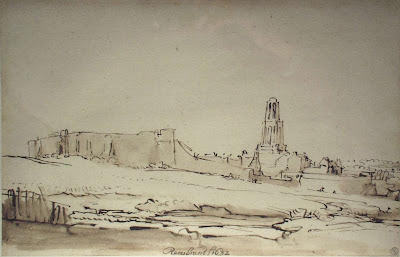What You Can Learn from Ink Wash Drawings
The ability to draw well is a hallmark of a real artist. If you want to be exciting, learn how to draw really, really well.
At least that's true in my book. Let me explain. I started out as an abstract painter because I couldn't draw from observation particularly well and all my teachers in undergraduate school pushed abstraction. But after a while I realized I needed something deeper in my painting and switched to working in a realist vein.
At first this meant building up my drawing skills. I did this almost entirely by working from the nude model. It was hard as heck to get the drawn figures to look human and to look like they weren't falling off the page. But after several thousand attempts I improved dramatically.
There's a problem with just drawing a model on a model stand. If you're not careful you develop the bad habit of just looking at the model. He or she is up there somewhat isolated from the rest of reality. While that's a good thing when one is just learning, art is ulitmately about finding connections between things that others have overlooked. We artists after all are in the relationship business. So I needed something to wean me away from this tendency.
My senior year at Oberlin my sister Kathy kindly sent me a book of Rembrant drawings as a present.
In the next few years I think I wore the binding on that book out from looking at it so much,
Now Rembrandt loved to work in ink washes. This was new technique to me as I had been using conte crayons as my primary medium. Drawing with thin veils of diluted drawing ink (Rembrandt probably made his own out of walnuts) has several amazing advantages. This medium makes it super easy to work with a wide range of tones (levels of dark and light). It trains your eye to be on the look out for tones instead of just lines and edges. You start out somewhat tentatively using very light washes that resemble tea where the teabag was yanked out of the cup after only a few seconds. This allows you to get a feeling for the composition gradually, almost stalking it like a cat would pursue a bird. As you get your bearings you gradually darkening the mixture to middle grey. And at the end, once you really know the terrain you can hit accents with ink that's nearly full strength.
You could say that in the drawings above Rembrandt was using his diluted inks to pull separted forms together into groups. But the word "groups" doesn't do him justice as he made those groups into elegantly expressively shapes. In the top drawing for example, look at the light grey forms in the distance. He's knit together a long wall at the left with a church steeple. Together they form a flat silhouette that reminds one of a comb with most of the teeth broken off.
In the second drawing, Rembrandt obviously loves the triangles of the thatched roof so he spot lights it by surrounding it with medium grey shadowed forms. Then at the left foreground, he pushes together a fragment of a house with an irregularly shaped tree to form another triagular shape that sort of rhymes with the middle house's roof. With the washes, he's pointing out to you how he's seeing a connection between forms that at first seemed completely separated.
Used properly the ink wash technique gives an almost instant sense of atmosphere to a drawing. In the top piece the far distant city feels like it's just beginning to dissolve into a subtle mist in the air. While in its foreground Rembrandt hits you with sharper and darker lines to describe a fence and stream that feel immediate and close.
Here's a detail out of one of Rembrandt's many self portraits. To me he conveys a thoughtfulness and even a soulfulness better that just about any other painter. Maybe I'm just in awe of Rembrandt because he was such a helpful teacher to me.
One a whim a few days ago I went to Google Images and entered " Rembrandt" and "Cat" just to see what came up. Check this out...






